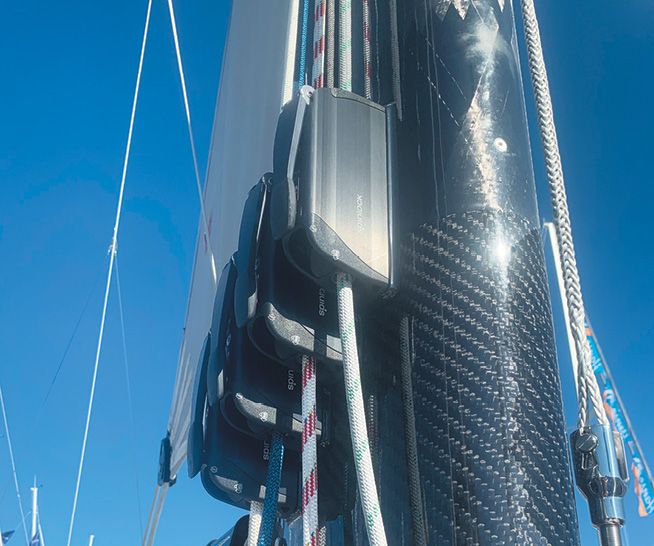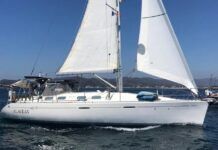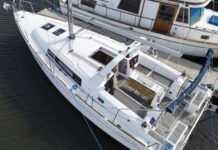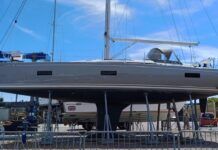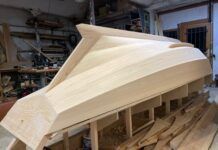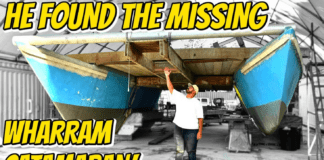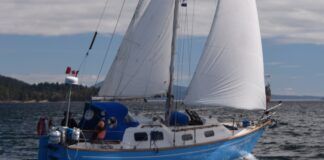Cross sheeting—directing the leeward jib sheet from the working winch across the cockpit to a winch on the windward side—is common practice on sport boats and single-handed boats. On sport boats, cross sheeting allows you to keep crew weight on the windward rail, yet still have the jib sheet nearby. For single-handers, especially those on tiller-steered or twin helm boats, cross sheeting conveniently redirects the headsail sheet to a winch on the windward side, where the helmsperson is usually stationed.
A related technique, sometimes referred to as cross hauling, is directing any line (not just a sheet) to a winch other than the one that is usually used to trim that line. The recent trend of leading all control lines to the cockpit, resulting in four or more lines directed through rope clutches to a single winch, can lead to a situation where there isn’t a winch available. To be able to tend one or more of these lines when its dedicated winch is already in use, a turning sheave (an open block mounted to the deck) is often used to redirect the line to an available winch.
The advantage of a turning sheave over a deck organizer or cheek block is that it is open, and a line can be dropped over it or taken out mid-line in a second. You don’t have to reeve and unreeve the line.
Winches are often used as turning sheaves when cross sheeting. Normally, when you use a winch, the direction of load matters. However, when a winch is used to redirect a line, the direction of pull doesn’t matter so much. Most winches on your boat should have enough reinforcement to redirect a line in any direction. The exception are winches mounted on coamings or pedestals, which may not be braced in all directions. This is also something to consider before using your coaming-mounted cockpit winch as a mooring bit for a stern line—a common mistake that can rip a hole in your coaming.
The load on the turning sheave will increase with deflection angle. A sheave with a 90-degree turn will be subjected to about 150 percent of the original straight-pull load. A sheave used for making a 180-degree turn will be subjected to 240 percent of the original straight-pull load.
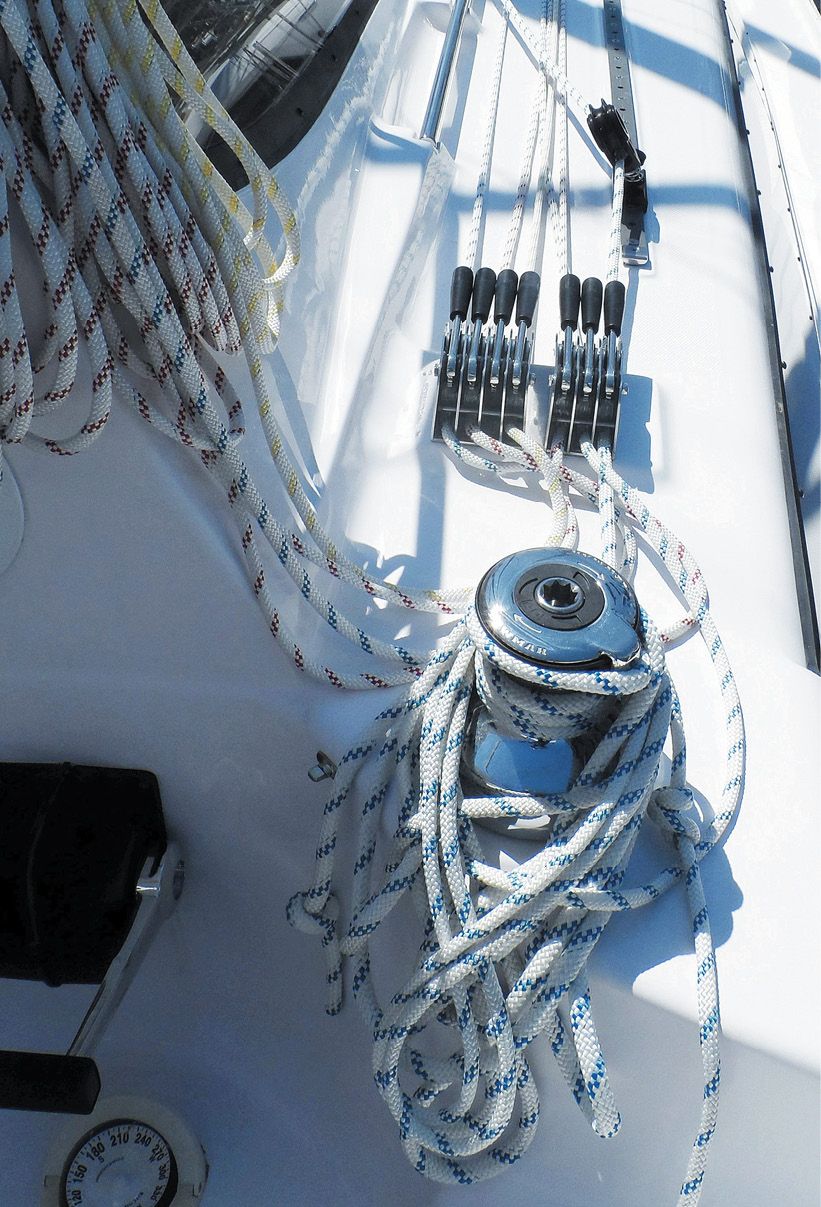
Ideally, the turning sheave should be properly aligned with the rope clutch and the lowest wrap on the winch it is serving. Likewise, to minimize strain on the rope clutch and friction on the line, a line should enter and exit a rope clutch in perfect alignment. However, this is impossible with multi-rope clutch banks.
Spinlock recommends no more than a 10-degree angle between the clutch and the winch. This translates to about 2.1 inches per foot from clutch to winch. Lewmar recommends no more than a 15-degree offset (3.1 inches per foot). Although many boat builders ignore this guidance, we don’t recommend it. Increasing the distance from the clutch bank to the winch will reduce the angle, but as a practical matter, you should mount rope clutches within easy reach of the winch they serve.
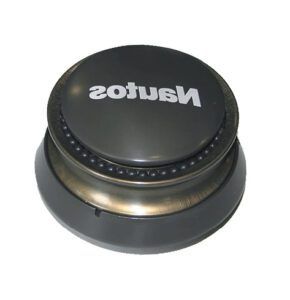
CONS OF CROSS SHEETING
Keeping the weight on the windward rail by cross sheeting sounds great, but there are some downsides. Some simple tricks will help to stay out of trouble.
The first problem is obvious. The sheet crosses the cockpit, creating a tripping hazard if you need to go forward to make another adjustment, duck below into the cabin, or do something on deck.
The most common method to cross sheet is to use the leeward winch as the turning block. This creates an inward force that might overload the fiberglass beneath a poorly reinforced winch. Winches that mount on a raised pedestal or pad makes them more vulnerable to overloading because of the added leverage.
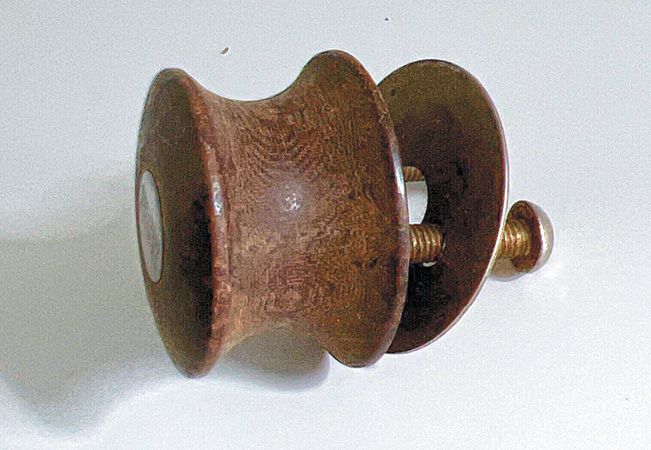
On port tack, the leeward winch still spins while trimming, but on starboard tack the locked drum adds friction. As a result, the sheet will release easily around the leeward winch on starboard tack, but there will be friction when releasing on port tack. Added friction during release could slow down the operation, particularly in light winds.
Some sport boat classes, including J-boats, locate a conventional turning block just slightly forward of the genoa winch. This allows the sheet to lead to winches on either side of the boat without creating additional friction.
Although sitting on the high side is desirable, remember that you still need to duck down to the leeward side every few minutes to check your blind spot.
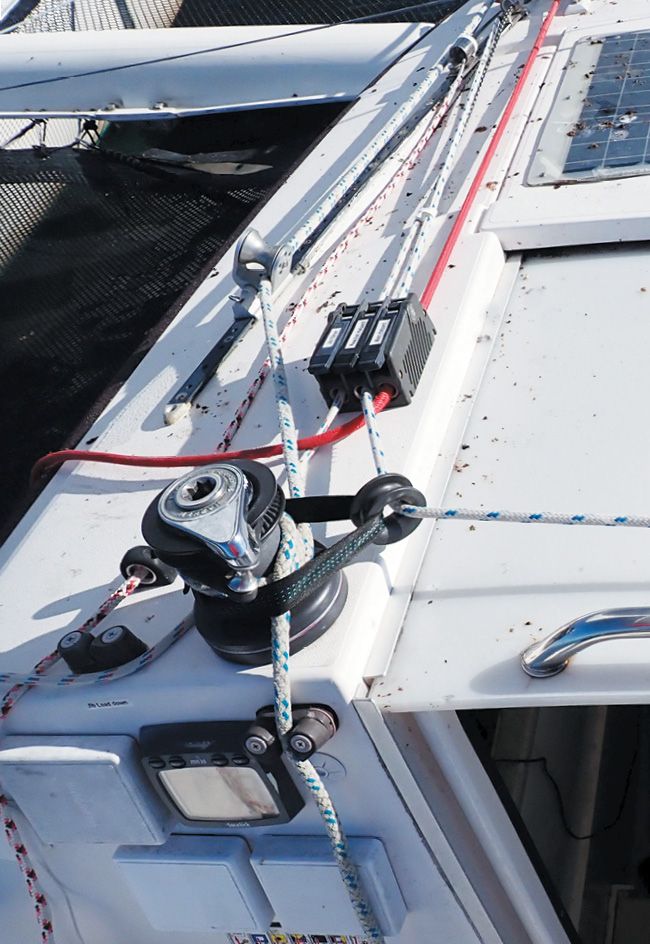
When tacking while cross sheeted, the sequence is just a little more complicated. You need to remove the sheet from the winch on the leeward side (being used as turning block) so that it will be available for the opposite sheet. If one person is going to control both sheets through the tack, the timing of the switch is critical. This is why racing boats have a separate turning block—so that the opposite winch is always available for the next tack.
PRODUCTS
We have used the Harken, Spinlock, and Nautos turning sheaves during sea trials. They are all high-quality and work predictably well. Although we’ve not tried the Antal models, based on a design review and our experience with other Antal products, we expect good performance. The Antal Tulip turning sheaves are shaped more like genoa lead blocks and can accept lines coming from a larger range of vertical angles (up to 40 degrees above). They stand about 20 percent taller than the other ones we’ve used. Prices for a 70 mm sheave start at $260 (more than the price of a used winch!) which is why we started looking for DIY solutions.
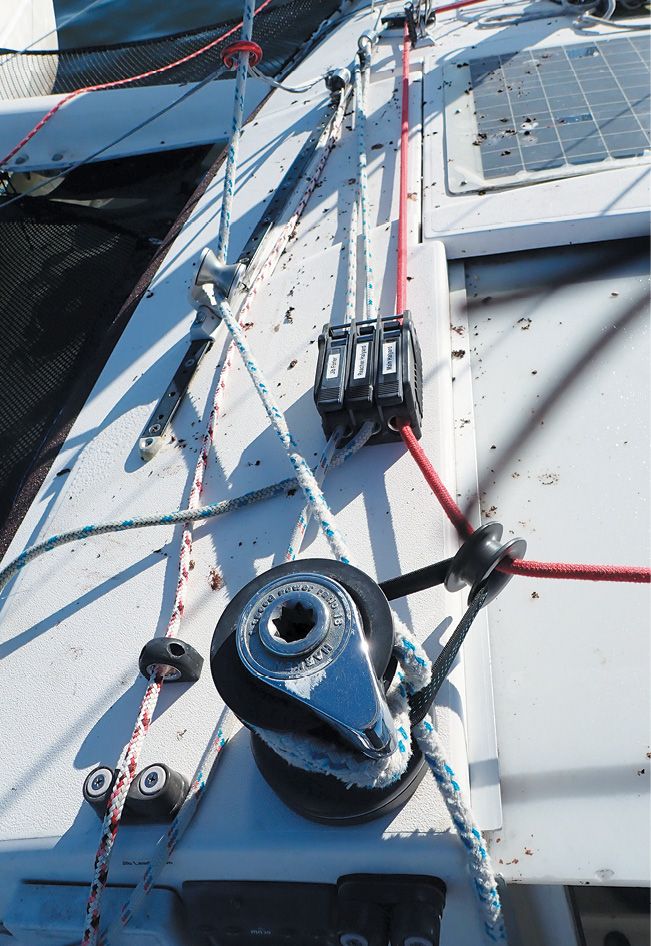
A DIY SOLUTION
A deck-mounted turning block is the elegant solution for frequent use, but what if you only rarely need to redirect a line? For example, on our test boat, a Corsair F-24 trimaran, we don’t cross sheet the jib when beating. It’s easy to tend the sheet at its usual position on the cabin top, and the boat is not sensitive to weight transfers. But we do have a few operations where halyards must be directed to another winch if the jib is in use. We can’t shake out a reef in the mainsail or hoist the reacher on starboard tack because the primary winch is holding the jib sheet.
If loads are moderate and the turning radius isn’t too sharp, a low friction ring can substitute for a ball-bearing turning sheave. A low friction ring is particularly well suited for operations that you don’t carry out frequently and won’t put too much load on the turning winch. The line needs to be properly aligned with the low friction ring, but a slight deviation would not be fatal. (It’s normal for line to exit a clutch at an upward angle between 10 and 20 degrees.)
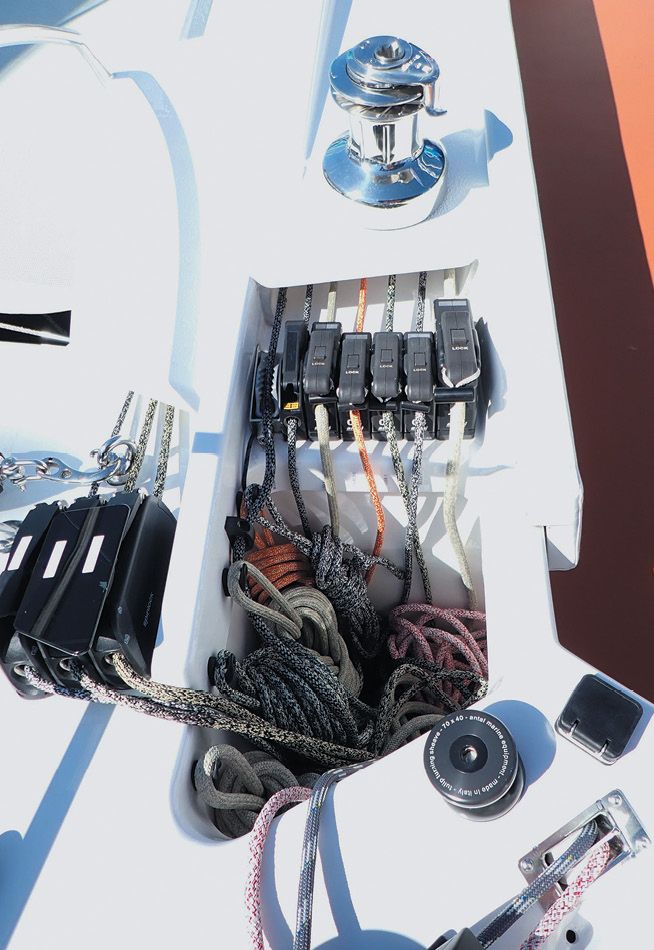
Our solution was to sew a large low-friction ring into a webbing sling, which we then dropped over the winch. The winch can be one that is already in use, as long as you don’t need to make any adjustments to the line it is holding. We chose webbing because a line might squeeze between the rope turns already on the drum. The loop should be sized to hold the ring as close to the winch as possible.
We did not seize the ring to the webbing, just passed the webbing through the ring’s center hole. We used a large ring with an opening 3 times the rope diameter to minimize friction. A ring that is two times the rope diameter is acceptable.
The only significant downside to this arrangement is that you must reeve the rope through the ring. While this can be a problem for cross sheeting, if you’re just re-routing a halyard or line that is used infrequently it’s an easy solution with no holes to drill.
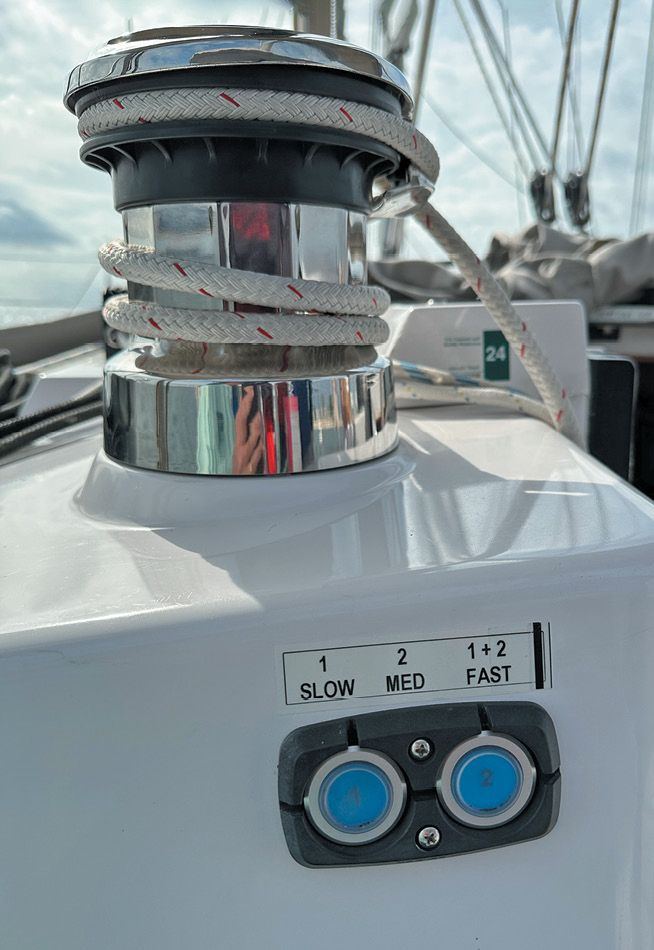
CONCLUSION
I’m a big believer in having some flexibility in the running rigging. This allows the skipper to arrange rigging that fits the situation—racing or cruising, in light winds or a gale. Cross sheeting and cross hauling enable this flexibility. Setting up an effective system for cross hauling system doesn’t require a big investment. Existing winches can become turning blocks. You can buy and bolt on an open-top sheave with ball bearings, or you can rig a portable DIY equivalent, a low friction ring on a sling. Having enough winches, where they are needed, is also important.
We’re not fans of the trend towards moving all lines to the helmsman and then trying to hide them. This leads to too much spaghetti in one spot and a reduces our options for re-routing lines where they will be more convenient. It’s a sailboat, after all, and boat designers should give us the tools we need to manage our running rigging.
CONTACTS
ANTAL, www.antal.it
HARKEN, www.harken.com
SPINLOCK, www.spinlock.co.uk
NAUTOS, www.nautos-usa.com
VALUE GUIDE: TURNING SHEAVES
| MAKER | PRODUCT | SIZES* | HEIGHT | WIDTH | WORKING LOAD | PRICE |
|---|---|---|---|---|---|---|
| ANTAL | TURNING SHEAVE | 50, 60, 70 | 44 MM | 82 MM | 1800 KG | $236.00 |
| ANTAL | TULIP TURNING SHEAVE | 50, 70, 100 | 52 MM | 70 MM | 1400 KG | $403.00 |
| SPINLOCK | WINCH FEEDER | 50, 63 | 25 MM | 63 MM | 2200 KG | $118.00 |
| HARKEN | CROSSOVER BLOCK | 44, 56 | 36 MM | 60 MM | 1361 KG | $263.00 |
| NAUTOS | CROSSDECK BLOCK | 75 | 36 MM | 81 MM | 3600 KG | $245.00 |
